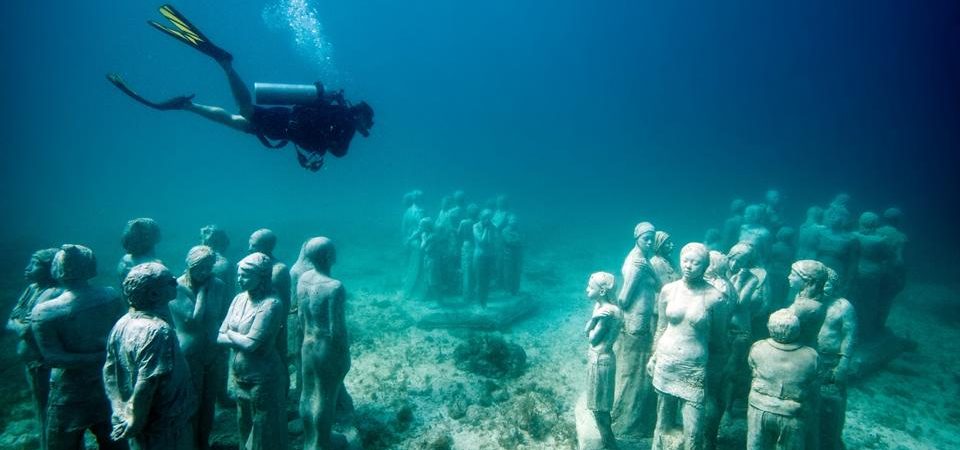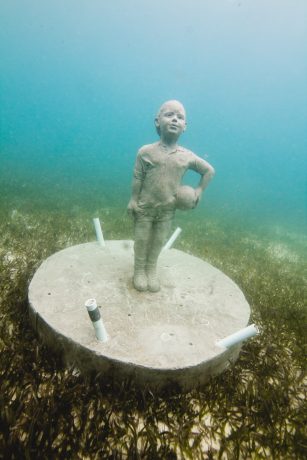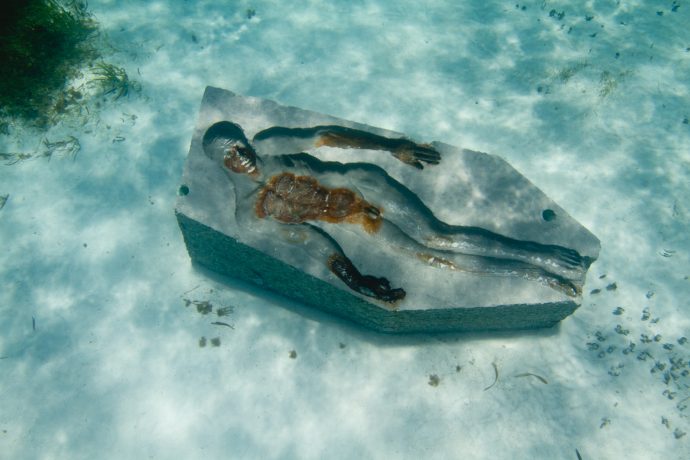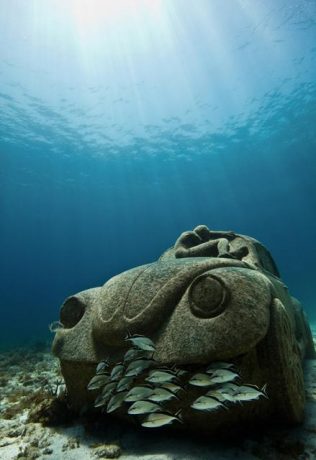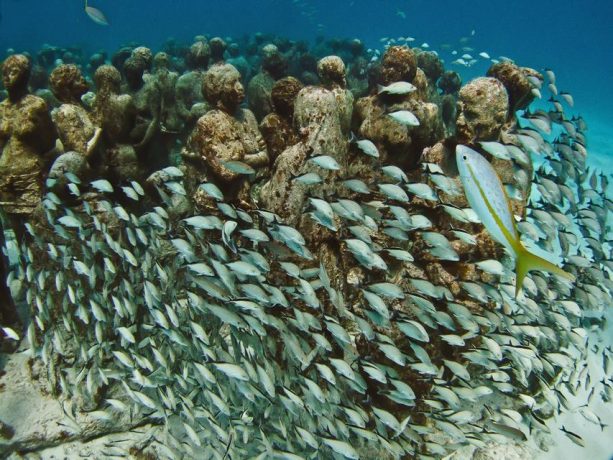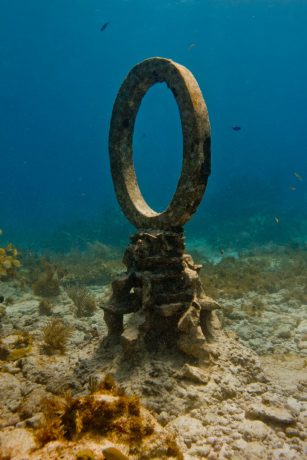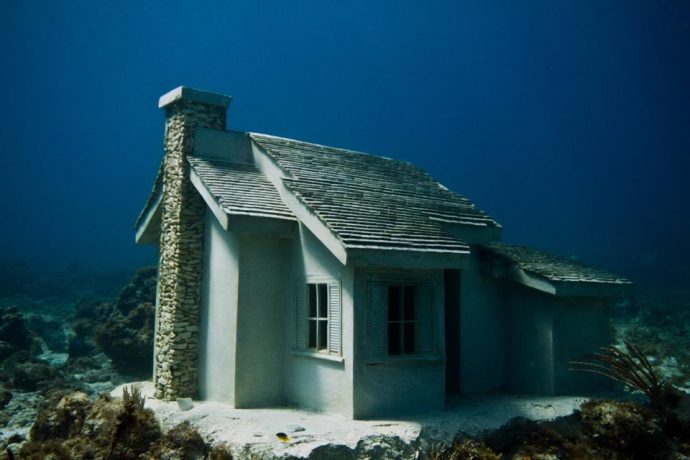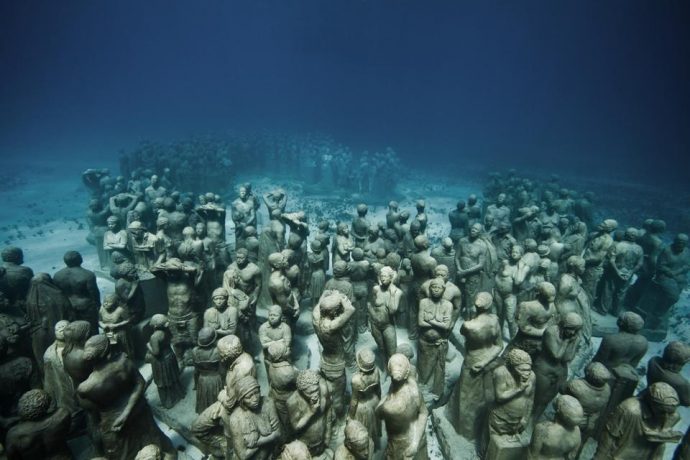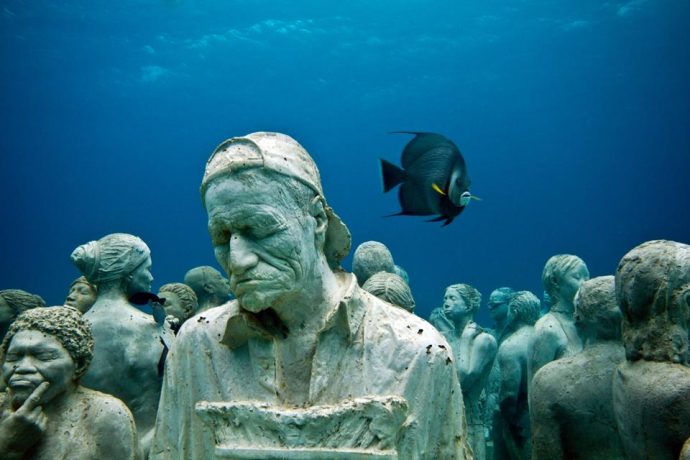These days, museums are located anywhere you can think of. Besides the traditional locations of historic sites, historic houses, and large art museums with fabulous modern architecture, there are museums inside skyscrapers, in former warehouses, in the open air, portable ones with no permanent location, and even some that only exist online. However, in Cancún, Mexico, there is a submerged art museum composed of 500 different sculptures installed on the ocean floor. Located in the clear water of the Caribbean Sea, the Cancún Underwater Museum, or MUSA (Museo Subacuático de Arte), opened to the public in 2010.
When I was a kid, I used to look at aquariums with various miniature statues, buildings, and other such decorations and wonder what it would be like to see them up close as the fish do. In a sense, MUSA’s sculpture collection is to us humans as exploring aquarium decorations is to fish. Of course, the underwater sculptures at MUSA are a form of amazing artwork and much more elaborate than anything in an aquarium. What I mean is that the Cancún Underwater Museum lets visitors explore an artificial sunken world (together with the fish) in the way you wish that you could when you stare into a well-designed aquarium somewhere.
Although MUSA is not the first of its kind, underwater museums are very rare. Upon hearing its name, you probably wonder how someone visits such a museum. The Underwater Museum itself recommends you snorkel or scuba dive in order to easily see its collection. Some parts of the museum are better seen snorkeling, while others are better while scuba diving. If you would rather stay dry, then a glass-bottom boat tour provides an alternative; however, many of the sculptures are in deep water and much easier to see while diving or snorkeling as MUSA recommends. Ultimately, the choice is yours, but if you are confident in your scuba diving or snorkeling ability, then you should try to see the underwater sculptures while being underwater yourself.
Another question you might be wondering is about the environmental aspect of an underwater sculpture park. With so much emphases today on removing objects from the ocean, such as plastic litter, why are people placing sculptures in it? The answer is to create a coral reef. Cancún is a popular vacation town, but with the tourism and travel comes damage to the coral reefs just off of its beaches. The sculptures were not only meant for artwork, but also to form new coral reefs as well. The goal is to bring potentially damaging amateur divers to see MUSA’s artwork rather than the natural reefs. This helps prevent damage to them. Each sculpture added is environmentally friendly so there is no threat to the water or ecosystem. Many outdoor museums, such as land sculpture parks, try to blend art and nature together. Similarly, MUSA uses art to grow and preserve nature through its coral-covered sculptures. In this case, placing objects in the ocean is actually a very good thing!
There are six sculptors with works on display at MUSA: Jason deCaires Taylor, Karen Salinas Martinez, Roberto Diaz Abraham, Rodrigo Quiñones Reyes, Salvador Quiroz Ennis, and Elier Amado Gil. Each artist provides MUSA with something unique, but Taylor is the most import in relation to the founding of the institution itself. Taylor not only first conceived of the concept of an underwater museum, but also co-planned the creation of the Cancún Underwater Museum. Of the 500 sculptures, two of my favorite are Urban Reef – House I and Urban Reef – House II by Taylor. The two Urban Reef – House sculptures stand out to me because of their difference from the numerous human sculptures; the two sculptures add variety to the Underwater Museum in the form of architectural-inspired sculptures. One interesting feature of the House sculptures is their open “windows.” These entry spaces allow fish to swim inside and use them as cover.
MUSA is composed of three different sculpture galleries. The shallowest of the three is Punta Sam, followed by the slightly deeper Punta Nizuc, and the largest and deepest one, Manchones. If you like to go snorkeling, then Punta Sam and Punt Nizuc provide a great opportunity for this, while Manchones at around 8 meters or 26 feet deep is best for a scuba diving adventure. Scuba diving is not for everyone, but I do recommend seeing Manchones if at all possible. The two Urban Reef – House sculptures are located there along with many others including The Silent Evolution I and The Silent Evolution II, also by Jason deCaires Taylor, composed of hundreds of human sculptures standing on the ocean floor.
Ultimately, the Cancún Underwater Museum illustrates several different things. For example, museums can truly be anywhere. Although there are a few others out there (and more planned for the future), underwater museums are still an extreme rarity. Also, art and nature are often intertwined. MUSA illustrates this with its 500 sculptures surrounded by fish, sea turtles, and other aquatic life. Finally, Cancún is a city whose economy is based on tourism and travel, but with this industry comes environmental damage. MUSA helps sustain the old natural reefs by bringing in tourists and inexperienced divers to see the Underwater Museum instead. Whether you are planning on Cancún, visiting for a totally different reason, or are going specifically to see the Cancún Underwater Museum, you are sure come away with a new idea of what a museum is and where it can be located!
